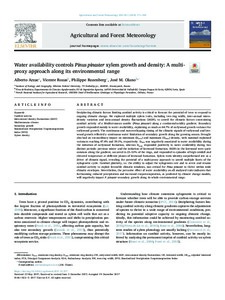Показать сокращенную информацию
Water availability controls Pinus pinaster xylem growth and density: A multiproxy approach along its environmental range
| Автор | Arzac, Alberto | |
| Автор | Rozas, Vicente | |
| Автор | Rozenberg, Philippe | |
| Автор | Olano, Jose Miguel | |
| Дата внесения | 2019-07-01T07:21:59Z | |
| Дата, когда ресурс стал доступен | 2019-07-01T07:21:59Z | |
| Дата публикации | 2018-03 | |
| Библиографическое описание | Arzac, Alberto. Water availability controls Pinus pinaster xylem growth and density: A multiproxy approach along its environmental range [Текст] / Alberto Arzac, Vicente Rozas, Philippe Rozenberg, Jose Miguel Olano // Agricultural and Forest Meteorology. — 2018. — С. 171-180 | |
| ISSN | 01681923 | |
| URI (для ссылок/цитирований) | https://www.sciencedirect.com/science/article/pii/S0168192317306779 | |
| URI (для ссылок/цитирований) | https://elib.sfu-kras.ru/handle/2311/110552 | |
| Описание | Текст статьи не публикуется в открытом доступе в соответствии с политикой журнала. | |
| Аннотация | Deciphering climatic factors limiting cambial activity is critical to forecast the potential of trees to respond to ongoing climatic change. We explored multiple xylem traits, including tree-ring width, inter-annual microdensity variation and intra-annual density fluctuations (IADF), to unveil the climatic factors constraining cambial activity of a Mediterranean conifer (Pinus pinaster) along a continental-aridity gradient. Secondary growth responded mainly to water availability, explaining as much as 64.7% of earlywood growth variance for earlywood growth. The continuous and non-overlapping timing of the climatic signals of earlywood and latewood growth reflected a continuous water limitation of secondary growth along the growing season. Drought also had an extraordinary impact on minimum (Dmin) and maximum (Dmax) density, with maximal explained variances reaching 47.4% and 39.1%, respectively. Dmin was negatively associated to water availability during the initiation of earlywood formation, whereas Dmax responded positively to water availability during two distinct periods: previous winter and the initiation of latewood formation. IADFs in the latewood were quite common along the gradient, occurred in 21–51% of the rings, and responded to episodes of high rainfall and elevated temperature at different phases of latewood formation. Xylem traits identity outperformed site as a driver of climatic signal, revealing the potential of a multi-proxy approach to unveil multiple facets of the xylogenetic cycle. Cambial plasticity, i.e. the ability to adjust the xylogenesis rate and to arrest and resume cambial activity to exploit favorable climatic windows, was critical for Pinus pinaster to thrive within wide climatic envelopes. Nevertheless, the pervasive effect of water availability on all analyzed traits indicates that forthcoming reduced precipitation and increased evapotranspiration, as predicted by climate change models, will negatively impact P. pinaster secondary growth along its whole environmental range. | |
| Тема | Cambial activity | |
| Тема | Intra-annual density fluctuations (IADF) | |
| Тема | Mediterranean climate | |
| Тема | Secondary growth | |
| Тема | Standardized Precipitation Evapotranspiration Index (SPEI) | |
| Тема | Xylem density | |
| Название | Water availability controls Pinus pinaster xylem growth and density: A multiproxy approach along its environmental range | |
| Тип | Journal Article | |
| Тип | Published Journal Article | |
| Страницы | 171-180 | |
| ГРНТИ | 34.35.25 | |
| Дата обновления | 2019-07-01T07:21:59Z | |
| DOI | 10.1016/j.agrformet.2017.12.257 | |
| Институт | Институт экологии и географии | |
| Подразделение | Кафедра экологии и природопользования | |
| Журнал | Agricultural and Forest Meteorology | |
| Квартиль журнала в Scopus | Q1 | |
| Квартиль журнала в Web of Science | Q1 |

